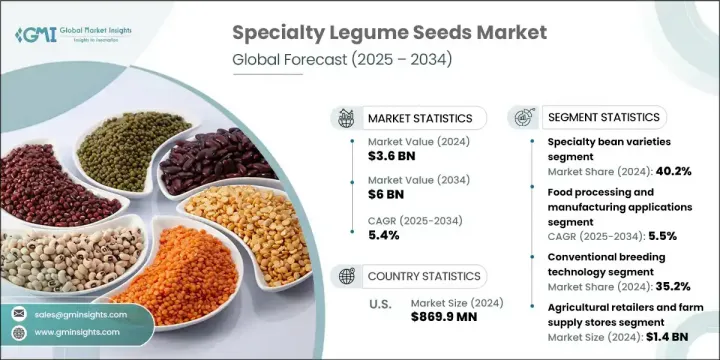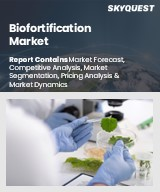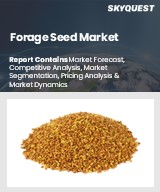
|
시장보고서
상품코드
1797811
세계의 특수 콩류 종자 시장 : 기회, 성장 촉진요인, 산업 동향 분석, 예측(2025-2034년)Specialty Legume Seeds Market Opportunity, Growth Drivers, Industry Trend Analysis, and Forecast 2025 - 2034 |
||||||
세계의 특수 콩류 종자 시장은 2024년 36억 달러로 평가되었으며 CAGR 5.4%로 성장해 2034년까지 60억 달러에 이를 것으로 추정됩니다.
이 분야의 성장의 원동력이 되고 있는 것은 식물성 영양에 대한 세계의 의식 상승과 생물학적 질소 고정을 통해 토양을 풍부하게 하는데 있어서 콩류가 담당하는 중요한 역할입니다. 이 씨앗은 풍부한 단백질, 비타민, 미네랄을 공급할뿐만 아니라 합성 비료의 필요성을 최소화하여 환경 친화적인 농법을 지원합니다. 또한 보존 기간이 길기 때문에 공급 체인이 끊어지는 시기에 있어서의 식량 안보를 위한 실용적인 솔루션이기도 합니다.

세계의 식량 수요가 증가함에 따라 고영양, 지속 가능한 종자를 사용한 작물 생산의 다양화에 다시 주목을 받고 있습니다. 건강한 식생활과 재생농업이 점점 중시되고 있는 가운데, 특수콩류 종자는 영양, 환경 지속성, 식량 회복력의 교차점에 위치하고 있습니다. 이 역동적인 시장은 각 지역에서 기세를 늘리고 있으며, 특히 소비자가 건강 지향 식품 선택을 선호하는 지역이 많습니다. 북미는 현재 시장 점유율로 선도하고 있지만, 이는 개발된 농업 부문과 지속 가능한 유기 재배법을 지원하는 정책 주도의 노력에 의한 것입니다.
| 시장 범위 | |
|---|---|
| 시작 연도 | 2024년 |
| 예측 연도 | 2025-2034년 |
| 시작 금액 | 36억 달러 |
| 예측 금액 | 60억 달러 |
| CAGR | 5.4% |
특수콩 부문은 2024년에 40.2%의 점유율을 차지했고 2034년까지 연평균 복합 성장률(CAGR) 5.6%를 보일 것으로 예측됩니다. 이 콩의 유형은 높은 수율 잠재력, 병해충에 대한 강한 내성, 우수한 영양 특성으로 선호됩니다. 식물 기반 식단과 지속 가능한 대체 단백질을 둘러싼 관심 증가는 이러한 품종에 대한 수요에 계속 영향을 미치고 있으며 생산성과 영양 성과를 모두 최적화하는 것을 목표로 한 지속적인 기술 혁신과 목표를 달성 한 육종 전략을 촉진하고 있습니다.
2024년에는 식품 가공 및 제조 부문이 12억 달러를 창출했으며, 이 부문은 2034년까지 연평균 복합 성장률(CAGR) 5.5%를 보일 것으로 예측됩니다. 콩류는 보존성, 영양가, 소비의 편리성을 높이는 기술 혁신이 수요를 크게 견인하고 있어 전통적인 식품 카테고리와 현대적인 식품 카테고리 모두에서 주식이 되고 있습니다.
2024년 미국 특수콩류 종자 시장 규모는 8억 6,990만 달러로, 2034년까지 CAGR 4.6%로 예측되고 있습니다. 미국 시장은 식물 기반 식품 소비의 급증과 유기농업시스템의 확대로 견인력을 늘리고 있습니다. 이 기세는 소비자의 강한 의식, 진화하는 농업 관행, 토양 친화적인 윤작에 보답하는 지원 정책에 의해 더욱 강화되고 있습니다. 캐나다는 또한 국가의 농업 프로그램이 지속 가능한 작물 생산과 콩과 식물의 환경 혜택을 촉진하기 때문에이 지역의 성장에 기여하고 있습니다.
세계의 특수 콩류 종자 시장을 형성하고 있는 톱 기업으로는 Corteva, Inc., Bayer AG, BASF SE(Agricultural Solutions), Syngenta AG, DLF Seeds A/S, Limagrain Group, Protealis 등이 있습니다. 특수 콩류 씨앗 시장의 선도 기업은 씨앗 혁신, 전략적 파트너십 및 지역 확대를 결합하여 추구하고 세계 발자국을 강화하고 있습니다. 유기농법과 지속가능한 농법에 적합한 고성능 내병성 콩과 품종의 개발에 중점을 두고 있습니다. 각 회사는 주요 지역의 특정 영양 및 기후 요구에 대응하기 위해 조사 능력을 강화하고 있습니다. 농업 기관과의 협력과 계약 재배 프로그램은 생산자 수준에서의 채용을 뒷받침하고 있습니다. 많은 기업들은 확장성과 일관된 종자 품질을 보장하기 위해 현지 생산 시설과 견고한 공급망 네트워크에 투자하고 있습니다.
목차
제1장 조사 방법
- 시장의 범위와 정의
- 조사 디자인
- 조사 접근
- 데이터 수집 방법
- 데이터 마이닝 소스
- 세계
- 지역/국가
- 기본 추정과 계산
- 기준연도 계산
- 시장 예측의 주요 동향
- 1차 조사와 검증
- 예측 모델
- 조사의 전제와 한계
제2장 주요 요약
제3장 업계 인사이트
- 생태계 분석
- 공급자의 상황
- 이익률
- 각 단계에서의 부가가치
- 밸류체인에 영향을 주는 요인
- 혁신
- 업계에 미치는 영향요인
- 성장 촉진요인
- 업계의 잠재적 위험 및 과제
- 시장 기회
- 성장 가능성 분석
- 규제 상황
- 북미
- 유럽
- 아시아태평양
- 라틴아메리카
- 중동 및 아프리카
- Porter's Five Forces 분석
- PESTLE 분석
- 가격 동향
- 지역별
- 제품별
- 미래 시장 동향
- 기술과 혁신의 상황
- 현재의 기술 동향
- 신흥기술
- 특허 상황
- 무역 통계(HS코드)(참고: 무역 통계는 주요 국가에서만 제공됨)
- 주요 수입국
- 주요 수출국
- 지속가능성과 환경 측면
- 지속가능한 관행
- 폐기물 감축 전략
- 생산에서의 에너지 효율
- 환경 친화적인 노력
제4장 경쟁 구도
- 소개
- 기업의 시장 점유율 분석
- 지역별
- 북미
- 유럽
- 아시아태평양
- 라틴아메리카
- 중동 및 아프리카
- 지역별
- 기업 매트릭스 분석
- 주요 시장 기업의 경쟁 분석
- 경쟁 포지셔닝 매트릭스
- 주요 발전
- 합병 및 인수
- 파트너십 및 협업
- 신제품 발매
- 확장 계획
제5장 시장 추계 및 예측 : 제품 유형별, 2021-2034년
- 주요 동향
- 특산콩 품종
- 토종 종과 전통 콩 품종
- 여러 가지 빛깔 콩과 외형이 특별한 콩
- 특별한 렌틸콩 품종
- 적, 흑, 그리고 특별한 색의 렌틸 콩
- 곡물이 크고 고품질의 렌틸 콩
- 병아리콩 특산품종
- 카브리 및 디지 특제품종
- 고단백으로 알갱이가 큰 병아리콩
- 신흥 콩 및 식물 품종
- 루피너스 품종
- 누에콩 특산품종
제6장 시장 추계 및 예측 : 용도별, 2021-2034년
- 주요 경향
- 식품 가공 및 제조 용도
- 식물 유래 단백질 원료 제조
- 육류 대체품 및 유제품 제조
- 글루텐 프리 및 특수 식품 제조
- 스낵 식품 및 편의점 제품에 응용
- 인간의 직접 소비
- 홀 푸드 및 자연 식품의 소매
- 레스토랑 및 푸드서비스 용도
- 건강식품 및 특수 식단
- 기능성 식품 및 영양 보조 식품 용도
- 영양보조식품 및 분말 제조
- 기능성 음료 및 스무디 용도
- 스포츠 영양 및 성능 제품
- 의료 식품 및 치료에 응용
- 가정 채소밭과 소규모 생산
- R&D 용도
제7장 시장 추계 및 예측 : 기술별, 2021-2034년
- 주요 동향
- 기존 육종 기술
- 고급 육종 기술
- 생명공학과 유전자 편집 시장 분석
- 종자 생산 및 가공 기술
제8장 시장 추계 및 예측 : 유통 채널별, 2021-2034년
- 주요 동향
- 농업 소매업체 및 농업 자재점
- 온라인 및 전자상거래 플랫폼
- 소비자 직접 판매 온라인 판매
- 농업 전자상거래 장소
- 특수 종자회사 웹사이트
- 소셜 미디어 및 디지털 마케팅 채널
- 특수 종자회사와 카탈로그
- 고정종 및 전통종 전문가
- 유기 및 지속가능한 종자회사
- 연구기관 및 대학
- 직접 판매와 농가 간의 네트워크
제9장 시장 추계 및 예측 : 지역별, 2021-2034년
- 주요 동향
- 북미
- 미국
- 캐나다
- 유럽
- 독일
- 영국
- 프랑스
- 이탈리아
- 스페인
- 기타 유럽
- 아시아태평양
- 중국
- 인도
- 일본
- 호주
- 한국
- 기타 아시아태평양
- 라틴아메리카
- 브라질
- 멕시코
- 아르헨티나
- 기타 라틴아메리카
- 중동 및 아프리카
- 사우디아라비아
- 남아프리카
- 아랍에미리트(UAE)
- 기타 중동 및 아프리카
제10장 기업 프로파일
- Bayer Crop Science
- Syngenta Group
- BASF Agricultural Solutions
- Corteva Agriscience
- Limagrain Group
- DLF Seeds A/S
- Protealis
- KWS SAAT SE & Co. KGaA
- Heritage Harvest Seed
- NuCicer Inc.
The Global Specialty Legume Seeds Market was valued at USD 3.6 billion in 2024 and is estimated to grow at a CAGR of 5.4% to reach USD 6 billion by 2034. Growth in this sector is fueled by rising global awareness of plant-based nutrition and the critical role legumes play in soil enrichment through biological nitrogen fixation. These seeds not only offer a rich source of protein, vitamins, and minerals, but they also support eco-conscious agricultural practices by minimizing the need for synthetic fertilizers. Their extended shelf life also makes them a practical solution for food security during periods of supply chain disruption.

As global food demands rise, there is a renewed focus on diversifying crop production using high-nutrient, sustainable seed options. With increasing emphasis on healthy diets and regenerative farming, specialty legume seeds are positioned at the intersection of nutrition, environmental sustainability, and food resilience. This dynamic market is gaining momentum across regions, especially where consumers are prioritizing wellness-driven food choices. North America currently leads in market share, benefiting from its well-developed agricultural sector and policy-driven initiatives that support sustainable and organic cultivation methods.
| Market Scope | |
|---|---|
| Start Year | 2024 |
| Forecast Year | 2025-2034 |
| Start Value | $3.6 Billion |
| Forecast Value | $6 Billion |
| CAGR | 5.4% |
The specialty bean segment held a 40.2% share in 2024 and is expected to grow at a CAGR of 5.6% through 2034. These bean types are preferred for their high yield potential, strong resistance to pests and diseases, and superior nutritional attributes. The surge in interest surrounding plant-based diets and sustainable protein alternatives continues to influence demand for these varieties, encouraging continuous innovation and targeted breeding strategies aimed at optimizing both productivity and nutritional outcomes.
In 2024, the food processing and manufacturing segment generated USD 1.2 billion, and this segment is forecast to grow at a CAGR of 5.5% by 2034, as more manufacturers adopt legumes into ready-to-eat meals, snacks, and health-oriented packaged goods. The demand is largely driven by innovations that enhance shelf life, nutritional value, and convenience in consumption-making legumes a staple in both traditional and modern food categories.
United States Specialty Legume Seeds Market generated USD 869.9 million in 2024, projected to rise at a CAGR of 4.6% through 2034. The U.S. market is gaining traction due to a sharp increase in plant-based food consumption and the expansion of organic farming systems. This momentum is further bolstered by strong consumer awareness, evolving agricultural practices, and supportive policies that reward soil-friendly crop rotations. Canada also contributes to regional growth, as national agricultural programs promote sustainable crop production and the environmental benefits of legumes.
The top companies shaping the Global Specialty Legume Seeds Market include Corteva, Inc., Bayer AG, BASF SE (Agricultural Solutions), Syngenta AG, DLF Seeds A/S, Limagrain Group, and Protealis. Leading players in the specialty legume seeds market are pursuing a combination of seed innovation, strategic partnerships, and regional expansion to strengthen their global footprint. A major focus is on developing high-performance, disease-resistant legume varieties tailored for organic and sustainable farming systems. Companies are enhancing their research capabilities to meet specific nutritional and climatic needs across key regions. Collaborations with agricultural institutions, as well as contract farming programs, are helping boost adoption at the grower level. Many are investing in local production facilities and robust supply chain networks to ensure scalability and consistent seed quality.
Table of Contents
Chapter 1 Methodology
- 1.1 Market scope and definition
- 1.2 Research design
- 1.2.1 Research approach
- 1.2.2 Data collection methods
- 1.3 Data mining sources
- 1.3.1 Global
- 1.3.2 Regional/Country
- 1.4 Base estimates and calculations
- 1.4.1 Base year calculation
- 1.4.2 Key trends for market estimation
- 1.5 Primary research and validation
- 1.5.1 Primary sources
- 1.6 Forecast model
- 1.7 Research assumptions and limitations
Chapter 2 Executive Summary
- 2.1 Industry 360° synopsis
- 2.2 Key market trends
- 2.2.1 Regional
- 2.2.2 Product type
- 2.2.3 Application
- 2.2.4 Technology
- 2.2.5 Distribution channel
- 2.3 TAM Analysis, 2025-2034
- 2.4 CXO perspectives: Strategic imperatives
- 2.4.1 Executive decision points
- 2.4.2 Critical success factors
- 2.5 Future Outlook and strategic recommendations
Chapter 3 Industry Insights
- 3.1 Industry ecosystem analysis
- 3.1.1 Supplier Landscape
- 3.1.2 Profit Margin
- 3.1.3 Value addition at each stage
- 3.1.4 Factor affecting the value chain
- 3.1.5 Disruptions
- 3.2 Industry impact forces
- 3.2.1 Growth drivers
- 3.2.2 Industry pitfalls and challenges
- 3.2.3 Market opportunities
- 3.3 Growth potential analysis
- 3.4 Regulatory landscape
- 3.4.1 North America
- 3.4.2 Europe
- 3.4.3 Asia Pacific
- 3.4.4 Latin America
- 3.4.5 Middle East & Africa
- 3.5 Porter's analysis
- 3.6 PESTEL analysis
- 3.7 Price trends
- 3.7.1 By region
- 3.7.2 By product
- 3.8 Future market trends
- 3.9 Technology and Innovation landscape
- 3.9.1 Current technological trends
- 3.9.2 Emerging technologies
- 3.10 Patent Landscape
- 3.11 Trade statistics (HS code) (Note: the trade statistics will be provided for key countries only)
- 3.11.1 Major importing countries
- 3.11.2 Major exporting countries
- 3.12 Sustainability and environmental aspects
- 3.12.1 Sustainable practices
- 3.12.2 Waste reduction strategies
- 3.12.3 Energy efficiency in production
- 3.12.4 Eco-friendly initiatives
Chapter 4 Competitive Landscape, 2024
- 4.1 Introduction
- 4.2 Company market share analysis
- 4.2.1 By region
- 4.2.1.1 North America
- 4.2.1.2 Europe
- 4.2.1.3 Asia Pacific
- 4.2.1.4 LATAM
- 4.2.1.5 MEA
- 4.2.1 By region
- 4.3 Company matrix analysis
- 4.4 Competitive analysis of major market players
- 4.5 Competitive positioning matrix
- 4.6 Key developments
- 4.6.1 Mergers & acquisitions
- 4.6.2 Partnerships & collaborations
- 4.6.3 New product launches
- 4.6.4 Expansion plans
Chapter 5 Market Estimates & Forecast, By Product Type, 2021-2034 (USD Million) (Kilo Tons)
- 5.1 Key trends
- 5.2 Specialty bean varieties
- 5.2.1 Heirloom and heritage bean varieties
- 5.2.2 Colored and specialty appearance beans
- 5.3 Specialty lentil varieties
- 5.3.1 Red, black, and specialty color lentils
- 5.3.2 Large-seeded and premium quality lentils
- 5.4 Specialty chickpea varieties
- 5.4.1 Kabuli and desi specialty varieties
- 5.4.2 High-protein and large-seeded chickpeas
- 5.5 Emerging legume varieties
- 5.5.1 Lupin bean varieties
- 5.5.2 Faba bean specialty varieties
Chapter 6 Market Estimates & Forecast, By Application, 2021-2034 (USD Million) (Kilo Tons)
- 6.1 Key trend
- 6.2 Food processing and manufacturing applications
- 6.2.1 Plant-based protein ingredient production
- 6.2.2 Alternative meat and dairy product manufacturing
- 6.2.3 Gluten-free and specialty food production
- 6.2.4 Snack food and convenience product applications
- 6.3 Direct human consumption
- 6.3.1 Whole food and natural product retail
- 6.3.2 Restaurant and food service applications
- 6.3.3 Health food and specialty diet
- 6.4 Functional food and nutraceutical applications
- 6.4.1 Dietary supplement and powder production
- 6.4.2 Functional beverage and smoothie applications
- 6.4.3 Sports nutrition and performance products
- 6.4.4 Medical food and therapeutic applications
- 6.5 Home gardening and small-scale production
- 6.6 Research and development applications
Chapter 7 Market Estimates & Forecast, By Technology, 2021-2034 (USD Million) (Kilo Tons)
- 7.1 Key trends
- 7.2 Conventional breeding technology
- 7.3 Advanced breeding technology
- 7.4 Biotechnology and gene editing market analysis
- 7.5 Seed production and processing technology
Chapter 8 Market Estimates & Forecast, By Distribution Channel, 2021-2034 (USD Million) (Kilo Tons)
- 8.1 Key trends
- 8.2 Agricultural retailers and farm supply stores
- 8.3 Online and E-commerce platforms
- 8.3.1 Direct-to-consumer online sales
- 8.3.2 Agricultural E-commerce marketplaces
- 8.3.3 Specialty seed company websites
- 8.3.4 Social media and digital marketing channels
- 8.4 Specialty seed companies and catalogs
- 8.4.1 Heirloom and heritage seed specialists
- 8.4.2 Organic and sustainable seed companies
- 8.5 Research institutions and universities
- 8.6 Direct sales and farmer-to-farmer networks
Chapter 9 Market Estimates & Forecast, By Region, 2021-2034 (USD Million) (Kilo Tons)
- 9.1 Key trends
- 9.2 North America
- 9.2.1 U.S.
- 9.2.2 Canada
- 9.3 Europe
- 9.3.1 Germany
- 9.3.2 UK
- 9.3.3 France
- 9.3.4 Italy
- 9.3.5 Spain
- 9.3.6 Rest of Europe
- 9.4 Asia Pacific
- 9.4.1 China
- 9.4.2 India
- 9.4.3 Japan
- 9.4.4 Australia
- 9.4.5 South Korea
- 9.4.6 Rest of Asia Pacific
- 9.5 Latin America
- 9.5.1 Brazil
- 9.5.2 Mexico
- 9.5.3 Argentina
- 9.5.4 Rest of Latin America
- 9.6 Middle East & Africa
- 9.6.1 Saudi Arabia
- 9.6.2 South Africa
- 9.6.3 UAE
- 9.6.4 Rest of Middle East & Africa
Chapter 10 Company Profiles
- 10.1 Bayer Crop Science
- 10.2 Syngenta Group
- 10.3 BASF Agricultural Solutions
- 10.4 Corteva Agriscience
- 10.5 Limagrain Group
- 10.6 DLF Seeds A/S
- 10.7 Protealis
- 10.8 KWS SAAT SE & Co. KGaA
- 10.9 Heritage Harvest Seed
- 10.10 NuCicer Inc.



















